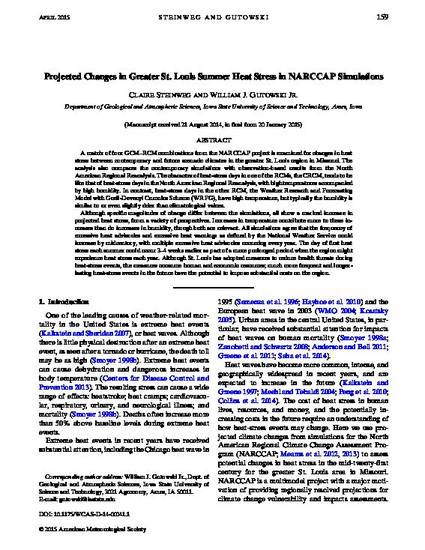
A matrix of four GCM–RCM combinations from the NARCCAP project is examined for changes in heat stress between contemporary and future scenario climates in the greater St. Louis region in Missouri. The analysis also compares the contemporary simulations with observation-based results from the North American Regional Reanalysis. The character of heat-stress days in one of the RCMs, the CRCM, tends to be like that of heat-stress days in the North American Regional Reanalysis, with high temperatures accompanied by high humidity. In contrast, heat-stress days in the other RCM, the Weather Research and Forecasting Model with Grell-Devenyi Cumulus Scheme (WRFG), have high temperature, but typically the humidity is similar to or even slightly drier than climatological values.
Although specific magnitudes of change differ between the simulations, all show a marked increase in projected heat stress, from a variety of perspectives. Increases in temperature contribute more to these increases than do increases in humidity, though both are relevant. All simulations agree that the frequency of excessive heat advisories and excessive heat warnings as defined by the National Weather Service could increase by midcentury, with multiple excessive heat advisories occurring every year. The day of first heat stress each summer could occur 3–4 weeks earlier as part of a more prolonged period when the region might experience heat stress each year. Although St. Louis has adopted measures to reduce health threats during heat-stress events, the measures consume human and economic resources; much more frequent and longer-lasting heat-stress events in the future have the potential to impose substantial costs on the region.
Available at: http://works.bepress.com/william-gutowski/16/

This article is from Weather, Climate, and Society 7 (2015): 159–168, doi:10.1175/WCAS-D-14-00041.1. Posted with permission.